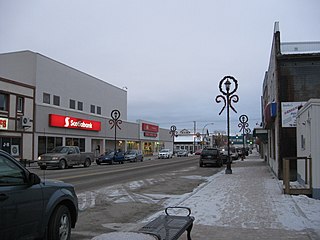
Flin Flon is a mining city, located on a correction line on the border of the Canadian provinces of Manitoba and Saskatchewan, with the majority of the city located within Manitoba. Residents thus travel southwest into Saskatchewan, and northeast into Manitoba. The city is incorporated in and is jointly administered by both provinces.
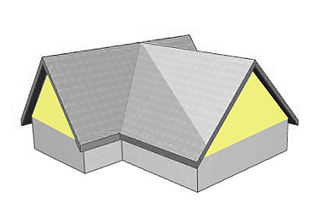
A gable is the generally triangular portion of a wall between the edges of intersecting roof pitches. The shape of the gable and how it is detailed depends on the structural system used, which reflects climate, material availability, and aesthetic concerns. The term gable wall or gable end more commonly refers to the entire wall, including the gable and the wall below it. Some types of roof do not have a gable. One common type of roof with gables, the gable roof, is named after its prominent gables.

The Northwest Railway Museum (NRM) is a railroad museum in Snoqualmie, King County, Washington. It incorporates a heritage railway, historic depot, exhibit hall, library, and collection care center, and serves more than 130,000 visitors per year.
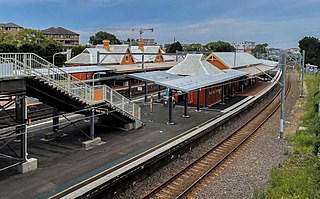
Arncliffe railway station is a heritage-listed railway station located on the Illawarra line, serving the Sydney suburb of Arncliffe in Bayside Council. It is served by Sydney Trains T4 line services. It was added to the New South Wales State Heritage Register on 2 April 1999.

Bulli railway station is a heritage-listed railway station on the South Coast railway line in New South Wales, Australia, serving the northern Wollongong suburb of Bulli. It was added to the New South Wales State Heritage Register on 30 August 2013.

Canterbury railway station is a heritage-listed railway station located on the Bankstown line at Canterbury in the City of Canterbury-Bankstown local government area of New South Wales, Australia. The station is served by Sydney Trains T3 Bankstown line services. The station was designed by New South Wales Government Railways and built from 1895 to 1915 by J. J. Scouller. It is also known as Canterbury Railway Station group. The property was added to the New South Wales State Heritage Register on 2 April 1999.

Scarborough railway station is a heritage-listed railway station on the South Coast railway line in New South Wales, Australia. It serves the seaside village of Scarborough. It was added to the New South Wales State Heritage Register on 2 April 1999.
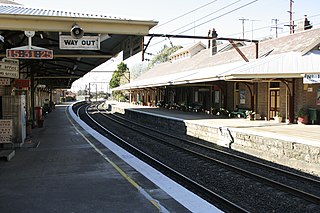
Mount Victoria railway station is a heritage-listed former barracks and now staff accommodation, guest accommodation, railway signal box and railway station located on the Main Western line in Mount Victoria in the City of Blue Mountains local government area of New South Wales, Australia. It was designed by NSW Government Railways and built from 1868 to 1913 by Allan McClean and James Barrie (1868 building). It is also known as Mount Victoria Railway Station group. The property was added to the New South Wales State Heritage Register on 2 April 1999. The station opened on 1 May 1868.

Lithgow railway station is a heritage-listed former station master's residence and railway station and now guest accommodation and railway station located on the Main Western line at Railway Parade, Lithgow, City of Lithgow, New South Wales, Australia. It was designed and built by New South Wales Government Railways and built from 1924 to 1925. It is also known as Lithgow Railway Station Group and Residence and Eskbank East. The property was added to the New South Wales State Heritage Register on 30 August 2013. The station has frequent NSW TrainLink services running to and from Sydney Central.
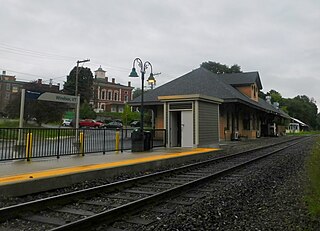
Windsor station, also known as Windsor–Mt. Ascutney, is an Amtrak intercity train station in Windsor, Vermont currently served by the Vermonter train over the New England Central Railroad line tracks.

Oakfield Station is a historic former passenger rail station on Station Street in Oakfield, Maine. The station was built in 1911 by the Bangor and Aroostook Railroad, and is a major reminder of Oakfield's onetime importance as a railroad center. The station is home to the Oakfield Railroad Museum which is operated by the Oakfield Historical Society. It was listed on the National Register of Historic Places on June 25, 1987.

The Lake of the Woods Ranger Station is a United States Forest Service compound consisting of eight buildings overlooking Lake of the Woods in the Fremont-Winema National Forests of southern Oregon. All of the ranger station structures were built by the Civilian Conservation Corps between 1937 and 1939. Today, the compound serves as a Forest Service work center, and the old ranger station office is a visitor center. The ranger station is listed on the National Register of Historic Places.

Maryborough railway station is a heritage-listed railway station at Lennox Street, Maryborough, Fraser Coast Region, Queensland, Australia. It is on the North Coast line serving the city of Maryborough. It was designed by Chief Engineer of the Queensland Railways Department and built from 1878 to 1890 by John Roddam & John Walker. It was added to the Queensland Heritage Register on 21 October 1992.

The Tenterfield railway station is a heritage-listed closed railway station and now railway museum located on the Main Northern line, Tenterfield, Tenterfield Shire, New South Wales, Australia. It served the town of Tenterfield and opened on 1 September 1886 when the line was extended from Glen Innes. It was the terminus of the line until it was extended to Wallangarra on 16 January 1888. The railway station was designed by William Murray under the direction of John Whitton, the Chief Engineer of NSW Government Railways, and built during 1886. It is also known as Tenterfield Railway Station group. The property was added to the New South Wales State Heritage Register on 2 April 1999. The station has one platform with two loops.

Nappanee Eastside Historic District is a national historic district located at Nappanee, Elkhart County, Indiana. The district encompasses 138 contributing buildings in a predominantly residential section of Nappanee. It was developed between about 1880 and 1940, and includes notable examples of Italianate, Queen Anne, Colonial Revival, and Prairie School style architecture. Located in the district are the separately listed Frank and Katharine Coppes House and Arthur Miller House.

Hibernian Hall is a heritage-listed community hall at 38–44 Hawthorne Street, Roma, Maranoa Region, Queensland, Australia. It was designed by Cavanagh & Cavanagh and built from 1931 to 1932 by George Power Williams. It is also known as HACBS Hall. It was added to the Queensland Heritage Register on 27 April 2001.

Cobar Post Office is a heritage-listed post office at 47 Linsley Street, Cobar, New South Wales, Australia. It was designed by James Barnet in 1885. It was added to the Australian Commonwealth Heritage List on 22 August 2012.

Temora Post Office is a heritage-listed post office at 173 Hoskins Street, Temora, New South Wales, Australia. It was added to the Australian Commonwealth Heritage List on 8 November 2011.
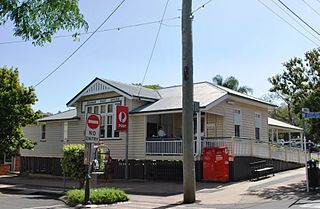
Boonah Post Office is a heritage-listed post office at 1 Park Street, Boonah, Scenic Rim Region, Queensland, Australia. The building was designed by the Queensland Government Architect's Office. It was added to the Australian Commonwealth Heritage List on 8 November 2011.

The Railways Department's Housing Scheme refers to a housing programme undertaken by the New Zealand's Railways during the 1920s. The scheme intended to provide Railway workers and their families with affordable and accessible accommodation during a time where it was overwise difficult to find suitable housing.





















